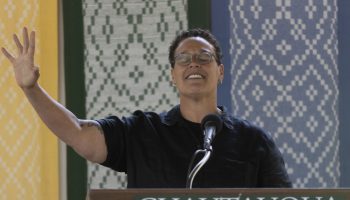When people talk about constitutional law, they almost invariably refer to the United States Constitution and federal law, but each state has its own constitution and its own supreme court.
“It’s like basketball,” said Judge Jeffrey S. Sutton, who has served on the United States Court of Appeals for the Sixth Circuit since 2003. “When you are unhappy with the law, you get two shots. Sometimes the second shot is the best.”
Before he was a federal appellate court judge, Sutton was state solicitor of Ohio. He has argued 12 cases in the United States Supreme Court and numerous cases in state supreme courts and federal courts of appeal. He knows how federal and state courts work, and he thinks that the states deserve more respect than they have traditionally received. In his recently published book, 51 Imperfect Solutions: States and the Making of American Constitutional Law, Sutton argues that a bias favoring federal jurisprudence has undermined and obscured the importance of state constitutional law.
“People think the heroes are the Supreme Court, and the villains are the states,” Sutton said. “That’s a mistake.”
At 3:30 p.m. Tuesday, July 31, in the Hall of Philosophy, Sutton will delve into the subject in a lecture titled “States and the Making of American Constitutional Law: Free Speech, Free Exercise of Religion and the Compelled Flag Salute Cases,” as part of the Oliver Archives Heritage Lecture Series.
Sutton, who teaches state constitutional law at the Ohio State University Moritz College of Law and Harvard Law School, is no stranger to Chautauqua. He was been coming to the Institution since he was 4, and his children are sixth-generation Chautauquans.
“I want to let people understand the history,” he said. “I’m trying to connect the role of state courts to what is going on with the U.S. Supreme Court today,” he said. “One concrete example is gerrymandering.”
Gerrymandering is the manipulation of electoral boundaries to unfairly favor one particular party over another. State legislators have been using it since 1812 to try to influence elections. Recently, state supreme courts in North Carolina and Pennsylvania have ruled the practice unconstitutional, but the U.S. Supreme Court has not taken a stand and has left it to the states to sort out.
There is long history of tension between the two appellate court systems. In his book, Sutton looks at famous cases that highlight that tension, and he will discuss at least two of them in his lecture.
One of the most infamous cases in American jurisprudence is Buck vs. Bell, a 1927 ruling that upheld 8-1 the right of Virginia to forcibly sterilize an 18-year-old woman who was judged “feebleminded.”
At the time, the eugenics movement, which posited that selective breeding of human beings could promote healthier, smarter and more upstanding people while curbing immorality, mental illness and other undesirable traits, was gaining acceptance throughout the West. It reached its nadir under the Nazis in Europe.
In the United States in 1927, at least 12 states had passed laws allowing authorities to sterilize people they deemed unfit to procreate. Many people sued in state courts, and most won. Carrie Buck was one such person. Her advocates argued that forced sterilization violated her rights of equal protection under the 14th Amendment.
The United States Supreme Court disagreed.
“Three generations of imbeciles is enough,” Justice Oliver Wendell Holmes wrote for the majority, upholding the Virginia law. Holmes’ celebrated colleagues Chief Justice William Howard Taft and Justice Louis Brandeis joined the opinion, with only Justice Pierce Butler dissenting.
In 1942, as the impact of eugenics laws became ever more apparent in the Third Reich, the Supreme Court ruled in Skinner vs. Oklahoma that persons thrice convicted of “moral turpitude” crimes should not be sterilized as was mandated under state law. That ruling effectively ended government-ordered sterilization in America, but Buck was never officially struck down.
“It’s still considered settled law, though none in their right mind would ever cite it,” Sutton said.

Another case that Sutton sees as emblematic of the tension between the state and federal high courts is West Virginia State Board of Education vs. Barnette in 1943, in which Justice Robert H. Jackson wrote in an eloquent majority opinion that the government could not force people to salute the American flag.
At issue was the right of a Jehovah’s Witness child not to salute the flag, as part of the group’s religious beliefs. Three years earlier, the court had upheld the right of a Pennsylvania school district to expel Jehovah’s Witness children who refused to pledge allegiance to the flag in a case called Minersville School District vs. Gobitis. The plaintiffs in Gobitis had won in state court, but lost in the Supreme Court.
Sutton attributes the court’s dramatic reversal to several factors, especially the influence of Jackson.
“Jackson was now on the court, and his reasoning was that you can’t make people say what they don’t want to say,” Sutton said.
Despite having never attending college and taking only one year of law school, Jackson was “one of the best writers, if not the best writer ever on the Supreme Court,” Sutton said.
“Great writing can sway opinion,” he said. “It was one of the most significant court decisions ever, second only to Brown vs. Board of Education.”
Some justices who had upheld Gobitis had changed their opinions as the world watched the Nazis enforcing similar laws. The fact that, in those days, the flag salute closely resembled the Hitler salute did not help, either.
The Barnette decision was announced, appropriately enough, on Flag Day.
“There is an assumption that the courts would protect the minority, but that wasn’t always true,” said Sutton, who himself has clerked for Supreme Court Justices Lewis F. Powell and Antonin Scalia. “The role of the courts in addressing the infringement of rights has really grown in the last 70 years.”
Sutton hopes his work explaining the divisions between state and federal jurisprudence may help in correcting this historic imbalance. But he is philosophical.
“We Americans love our rights,” he said. “But we fiercely disagree over which ones to protect.”





